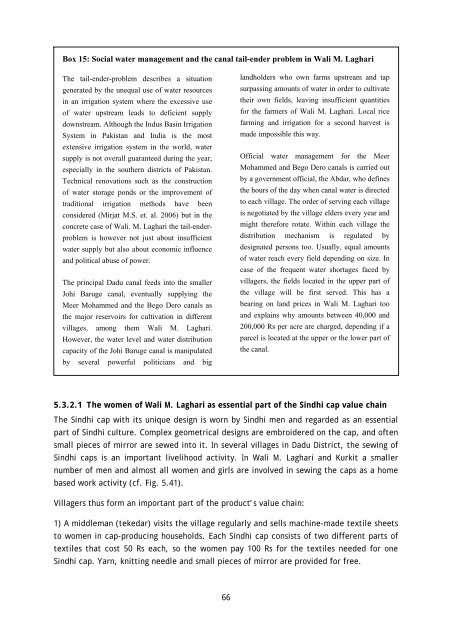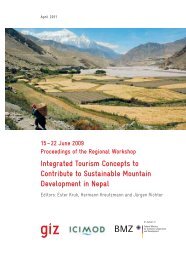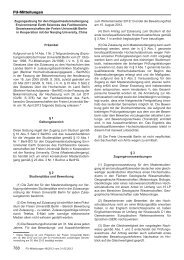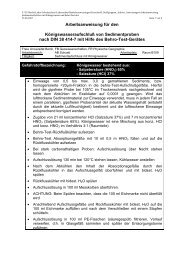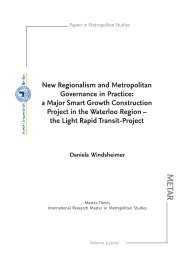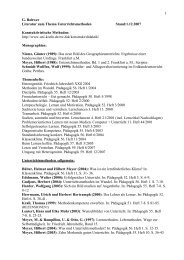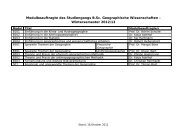After the Flood in Pakistan 38 Berlin Geographical Papers - Freie ...
After the Flood in Pakistan 38 Berlin Geographical Papers - Freie ...
After the Flood in Pakistan 38 Berlin Geographical Papers - Freie ...
You also want an ePaper? Increase the reach of your titles
YUMPU automatically turns print PDFs into web optimized ePapers that Google loves.
Box 15: Social water management and <strong>the</strong> canal tail-ender problem <strong>in</strong> Wali M. Laghari<br />
The tail-ender-problem describes a situation<br />
generated by <strong>the</strong> unequal use of water resources<br />
<strong>in</strong> an irrigation system where <strong>the</strong> excessive use<br />
of water upstream leads to deficient supply<br />
downstream. Although <strong>the</strong> Indus Bas<strong>in</strong> Irrigation<br />
System <strong>in</strong> <strong>Pakistan</strong> and India is <strong>the</strong> most<br />
extensive irrigation system <strong>in</strong> <strong>the</strong> world, water<br />
supply is not overall guaranteed dur<strong>in</strong>g <strong>the</strong> year,<br />
especially <strong>in</strong> <strong>the</strong> sou<strong>the</strong>rn districts of <strong>Pakistan</strong>.<br />
Technical renovations such as <strong>the</strong> construction<br />
of water storage ponds or <strong>the</strong> improvement of<br />
traditional irrigation methods have been<br />
considered (Mirjat M.S. et. al. 2006) but <strong>in</strong> <strong>the</strong><br />
concrete case of Wali. M. Laghari <strong>the</strong> tail-enderproblem<br />
is however not just about <strong>in</strong>sufficient<br />
water supply but also about economic <strong>in</strong>fluence<br />
and political abuse of power.<br />
The pr<strong>in</strong>cipal Dadu canal feeds <strong>in</strong>to <strong>the</strong> smaller<br />
Johi Baruge canal, eventually supply<strong>in</strong>g <strong>the</strong><br />
Meer Mohammed and <strong>the</strong> Bego Dero canals as<br />
<strong>the</strong> major reservoirs for cultivation <strong>in</strong> different<br />
villages, among <strong>the</strong>m Wali M. Laghari.<br />
However, <strong>the</strong> water level and water distribution<br />
capacity of <strong>the</strong> Johi Baruge canal is manipulated<br />
by several powerful politicians and big<br />
66<br />
landholders who own farms upstream and tap<br />
surpass<strong>in</strong>g amounts of water <strong>in</strong> order to cultivate<br />
<strong>the</strong>ir own fields, leav<strong>in</strong>g <strong>in</strong>sufficient quantities<br />
for <strong>the</strong> farmers of Wali M. Laghari. Local rice<br />
farm<strong>in</strong>g and irrigation for a second harvest is<br />
made impossible this way.<br />
Official water management for <strong>the</strong> Meer<br />
Mohammed and Bego Dero canals is carried out<br />
by a government official, <strong>the</strong> Abdar, who def<strong>in</strong>es<br />
<strong>the</strong> hours of <strong>the</strong> day when canal water is directed<br />
to each village. The order of serv<strong>in</strong>g each village<br />
is negotiated by <strong>the</strong> village elders every year and<br />
might <strong>the</strong>refore rotate. With<strong>in</strong> each village <strong>the</strong><br />
distribution mechanism is regulated by<br />
designated persons too. Usually, equal amounts<br />
of water reach every field depend<strong>in</strong>g on size. In<br />
case of <strong>the</strong> frequent water shortages faced by<br />
villagers, <strong>the</strong> fields located <strong>in</strong> <strong>the</strong> upper part of<br />
<strong>the</strong> village will be first served. This has a<br />
bear<strong>in</strong>g on land prices <strong>in</strong> Wali M. Laghari too<br />
and expla<strong>in</strong>s why amounts between 40,000 and<br />
200,000 Rs per acre are charged, depend<strong>in</strong>g if a<br />
parcel is located at <strong>the</strong> upper or <strong>the</strong> lower part of<br />
<strong>the</strong> canal.<br />
5.3.2.1 The women of Wali M. Laghari as essential part of <strong>the</strong> S<strong>in</strong>dhi cap value cha<strong>in</strong><br />
The S<strong>in</strong>dhi cap with its unique design is worn by S<strong>in</strong>dhi men and regarded as an essential<br />
part of S<strong>in</strong>dhi culture. Complex geometrical designs are embroidered on <strong>the</strong> cap, and often<br />
small pieces of mirror are sewed <strong>in</strong>to it. In several villages <strong>in</strong> Dadu District, <strong>the</strong> sew<strong>in</strong>g of<br />
S<strong>in</strong>dhi caps is an important livelihood activity. In Wali M. Laghari and Kurkit a smaller<br />
number of men and almost all women and girls are <strong>in</strong>volved <strong>in</strong> sew<strong>in</strong>g <strong>the</strong> caps as a home<br />
based work activity (cf. Fig. 5.41).<br />
Villagers thus form an important part of <strong>the</strong> product’s value cha<strong>in</strong>:<br />
1) A middleman (tekedar) visits <strong>the</strong> village regularly and sells mach<strong>in</strong>e-made textile sheets<br />
to women <strong>in</strong> cap-produc<strong>in</strong>g households. Each S<strong>in</strong>dhi cap consists of two different parts of<br />
textiles that cost 50 Rs each, so <strong>the</strong> women pay 100 Rs for <strong>the</strong> textiles needed for one<br />
S<strong>in</strong>dhi cap. Yarn, knitt<strong>in</strong>g needle and small pieces of mirror are provided for free.


